September 2022
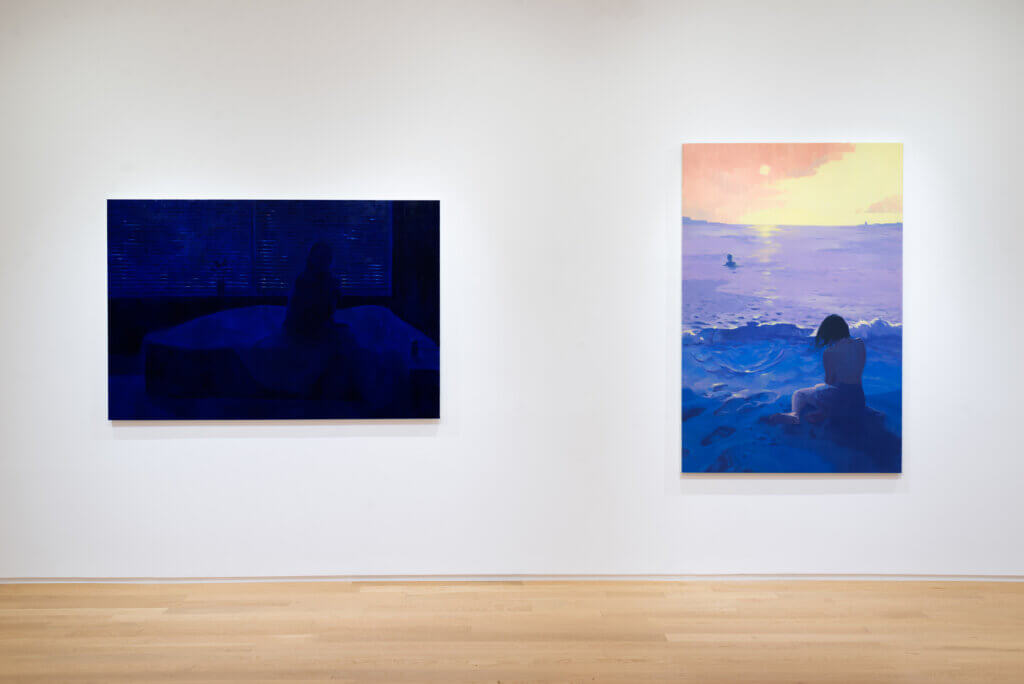
Yuri Yuan: Dark Dreams (September 7-October 12, 2022) at Alexander Berggruen, New York.
On the occasion of our exhibition Yuri Yuan: Dark Dreams (September 7-October 12, 2022), Yuri Yuan shares insight into the narrative, influences, and symbolism in the show.
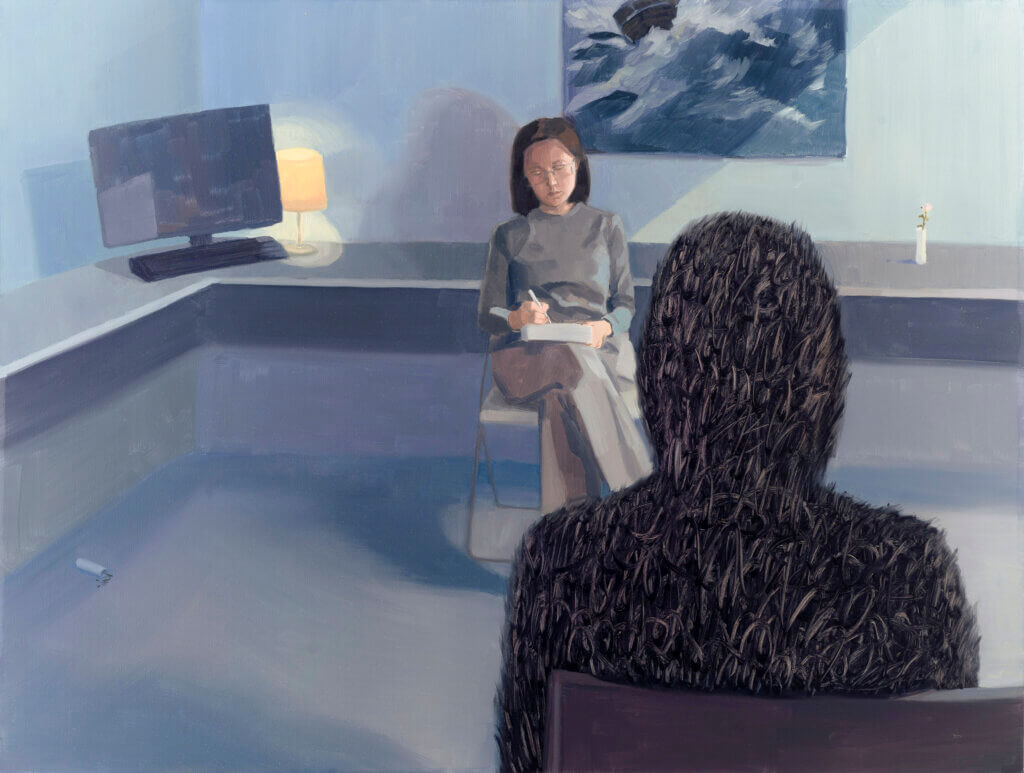
Yuri Yuan
The Storm in Me, 2022
oil on linen
36 x 48 in. (91.4 x 121.9 cm.)
I consider this painting to be the key (as in map) to understanding this group of work. There are three perspectives I considered while making this painting. The first layer is personal: I went through almost two years of therapy during graduate school to work through anxiety, depression, and Post-traumatic stress disorder (PTSD) caused by personal trauma. The second layer is occupational: I think quite often people romanticize the mental health problems of artists (like how much the narrative of Van Gogh is surrounded by his mental health problems. Few people ask why he has mental problems, and how we can learn from his tragedy. Instead, we assume “madness” is a necessary or favorable condition for making good art). The third layer is social: In his book Capitalist Realism, Mark Fisher highlights mental health as one of the consequences of capitalist society. (1)
Instead of treating it as incumbent on individuals to resolve their own psychological distress, instead, that is, of accepting the vast privatization of stress that has taken place over the last thirty years, we need to ask: how has it become acceptable that so many people, and especially so many young people, are ill? The ‘mental health plague’ in capitalist societies would suggest that instead of being the only social system that works, capitalism is inherently dysfunctional and that the cost of it appearing to work is very high. (1)
In the painting, I turn a conversation between a therapist and a patient into two images of myself: a rational version (painted in a representational style) and an abstract version (painted with black brushstrokes). This black (actually a very deep purple) shape represents how I feel being in therapy, suppressing the dark side of me with rationality. The painting behind the therapist references a shipwreck, a projection of the patient’s state of mental health. The broken vase on the floor on the left side of the canvas and the healthy flower growing in the sunlight on the right represent the journey of healing.
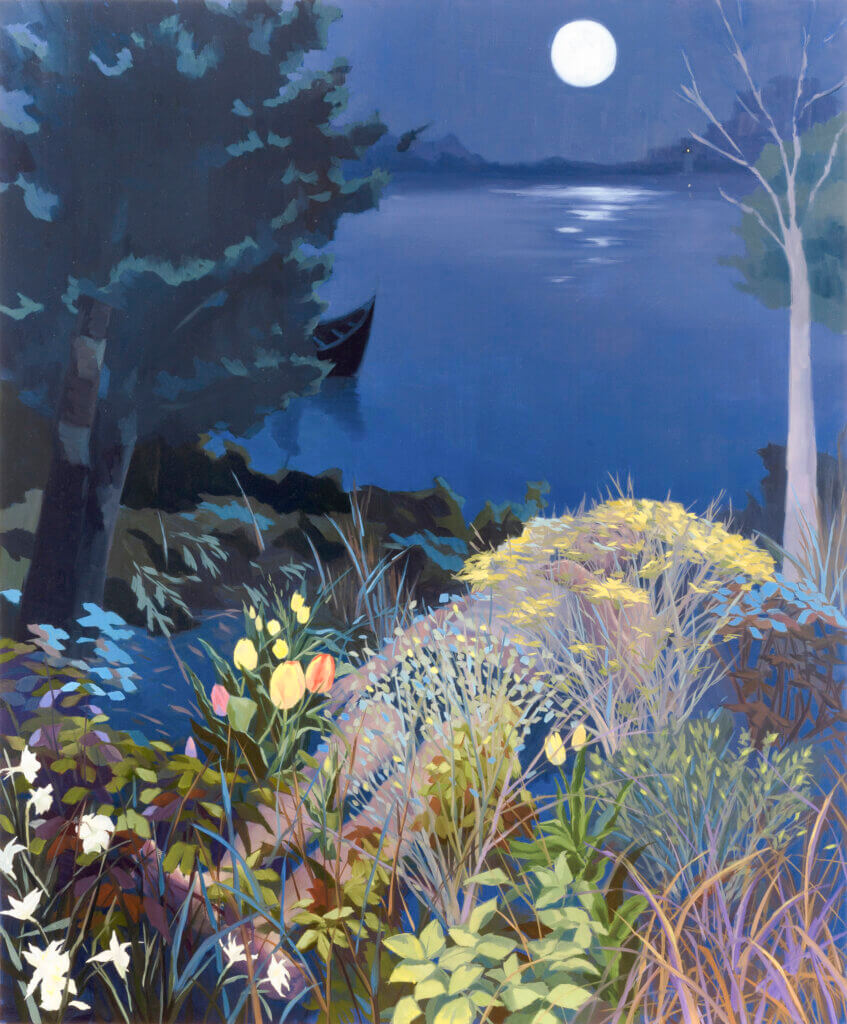
Yuri Yuan
Will You Remember Me, 2022
oil on linen
72 x 60 in. (182.9 x 152.4 cm.)
At the beginning of 2022, I had some occasional heart pains. Before I had a cardiologist check it out, I thought I was going to die from heart attacks. (It turned out I only had a very small heart problem, not even big enough to have drugs prescribed. The doctor just told me to drink more water.)
The fear and anxiety that I may die from a sudden heart attack like my father did, had me thinking about what would happen after my death. Will I die in a poetic way? Like a John Everett Millais painting? Or will I die in a grotesque way, like a Goya?
When the viewer first looks at the painting, they are distracted by the flower in the foreground. The vibrant colors lure the viewer to come closer to the painting. The landscape is inspired by Arnold Böcklin’s paintings (Isle of the Dead [1883], among many others).
One would only notice the figure when one steps further away from the painting. The figure is lying on the ground, hand on her chest. Next to the tree, there is a black boat, beneath the boat is a reflection of a ferryman. In Greek mythology, Charon, the ferryman of Hades, carries the soul of the deceased from the living world to the underworld across the river Acheron (the river of misery, one of the five rivers of Hades’ underworld). Another infernal river is Lethe, the river of forgetfulness. The spirits of the dead need to drink from the waters of Lethe in order to forget their lives on earth so that they can be reincarnated. I liked this idea of being remembered vs being forgotten. Which one is more desirable? Who knows.
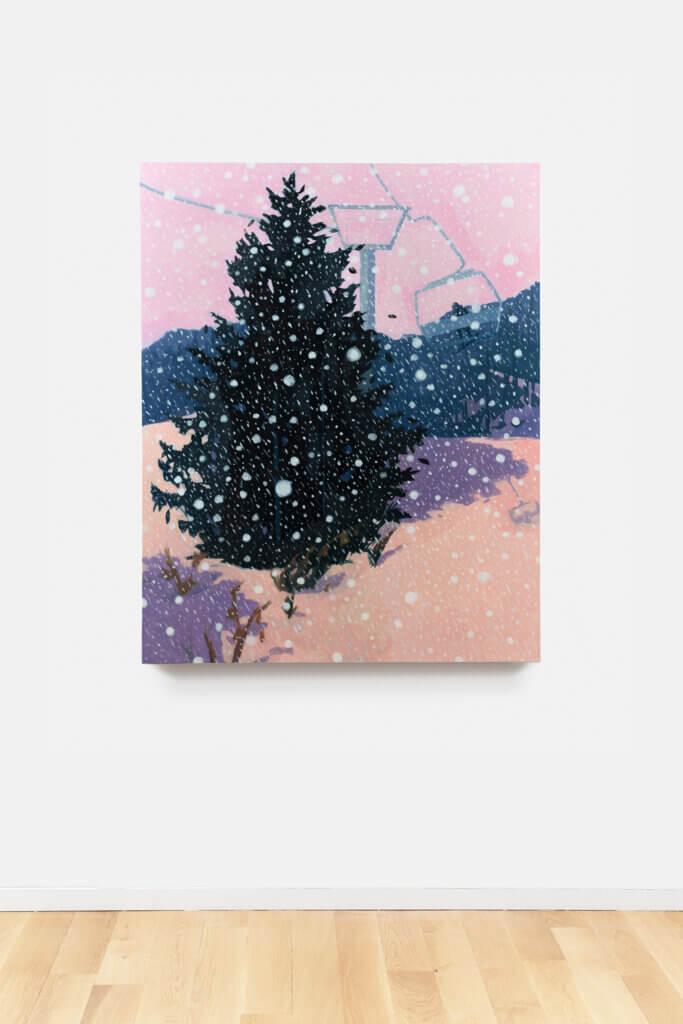
Yuri Yuan
Snow Storm, 2022
oil on canvas
60 x 48 in. (152.4 x 121.9 cm.)
Snow Storm is painted from imagination. I like to ski but I’ve never been stuck on a ski lift, nor have I ever seen a ski resort with pink snow. The pink makes the scene romantic and nostalgic, disguising the looming danger.

Yuri Yuan
Resurgence, 2022
oil on linen
72 x 60 in. (182.9 x 152.4 cm.)
This is a painting that looks quite different from any other paintings I have ever made. It combines a lot of art history references from different cultures. The main influence of this painting is the story of Saint George and the Dragon. When I visited the National Gallery in London, I noticed that this classic tale of a man slaying an evil dragon to save a princess was repeated again and again as a symbol of military prowess.
In my version, I erased the damsel in distress and used a female warrior figure instead. For the figure, I drew references from the arms and armor gallery at The Met and the mythological figure of Amazon warriors like Penthesilea who faced Achilles in the Trojan War.
The horse she’s riding on references inking drawings of Chinese artist Xu Beihong, as I found ink drawings express movement and gestures way better than photos.
The harness of the horse is decorated with ornaments resembling Medusa, a symbol of female rage.
I also changed the “dragon” to a dark shape that is similar to the one in The Storm In Me. In the contemporary age, we no longer fear dragons. The fears we have are much more abstract, the fear of catching covid, the fear of losing someone we love, the fear of an economic recession or war, things that we have absolutely no control over. The background of the painting references Medieval/early Renaissance paintings in terms of the colors, as well as the composition (landscape stacking on top of each other as compared to a two-point perspective drawing in late Renaissance).
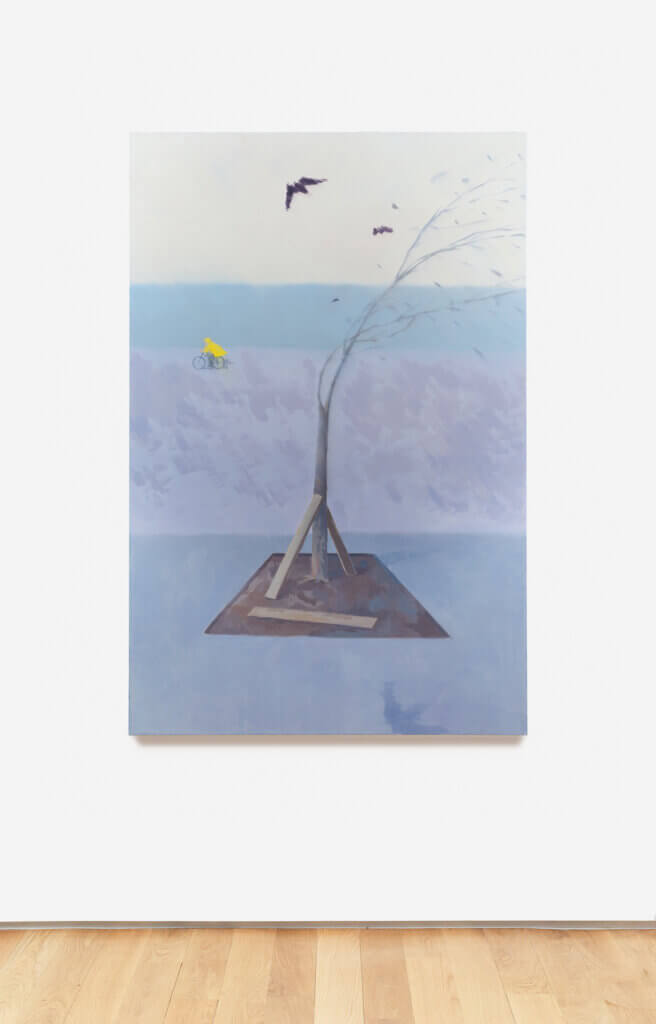
Yuri Yuan
Take Me Down Easy, 2022
oil on linen
72 x 48 in. (182.9 x 121.9 cm.)
This painting is influenced by James Henry Jr.’s song “Take Me Down Easy”. The song writes from the perspective of a tree moving in the wind of a pending storm, with a sense of helplessness and bravery. I interpret the lyrics to be metaphors for depression, especially the part ‘Cause there was no sunlight, Just ask my mother. When I treated myself hard, I crumble and fall.’ (2) Another reason was that I first heard this song played at the end of a Bojack Horseman episode. The title of the episode was “The Face Of Depression,” in which the characters ask what people with depression look like, and whether someone who looks happy can be depressed.
The color palette of this painting is much more muted as compared to the rest. It is meant to be a breathing moment in the show. The birds/bats in the sky are painted in a similar way as the “dragon” in Resurgence, and the patient in The Storm In Me.
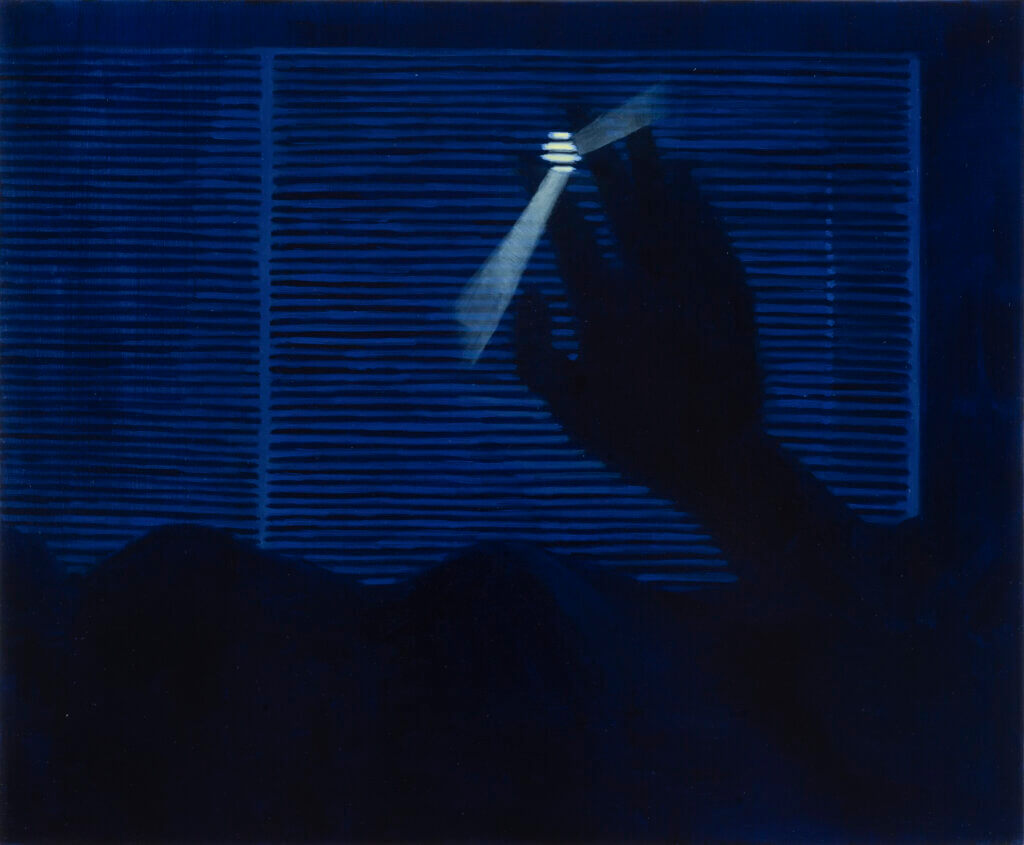
Yuri Yuan
The Blue of Distance, 2022
oil on linen
20 x 24 in. (50.8 x 61 cm.)
Thanks to the view from my apartment I was able to look at every full moon, new moon, blood moon, and super moon. They were so beautiful, so elegant. No matter how many photos I take, what cameras I use, or where I went to take pictures, I cannot capture the beauty of the moon. After a while, I stopped looking at the moon, because the thought of eventually losing the moon made me sad. One night I woke up in the middle of the night, the moon was big and bright like someone was shining a spotlight on my face. I tried to touch the moon. The title of this piece comes from Rebecca Solnit’s book A Field Guide to Getting Lost: “Blue is the color of longing for the distances you will never arrive in…” (3)
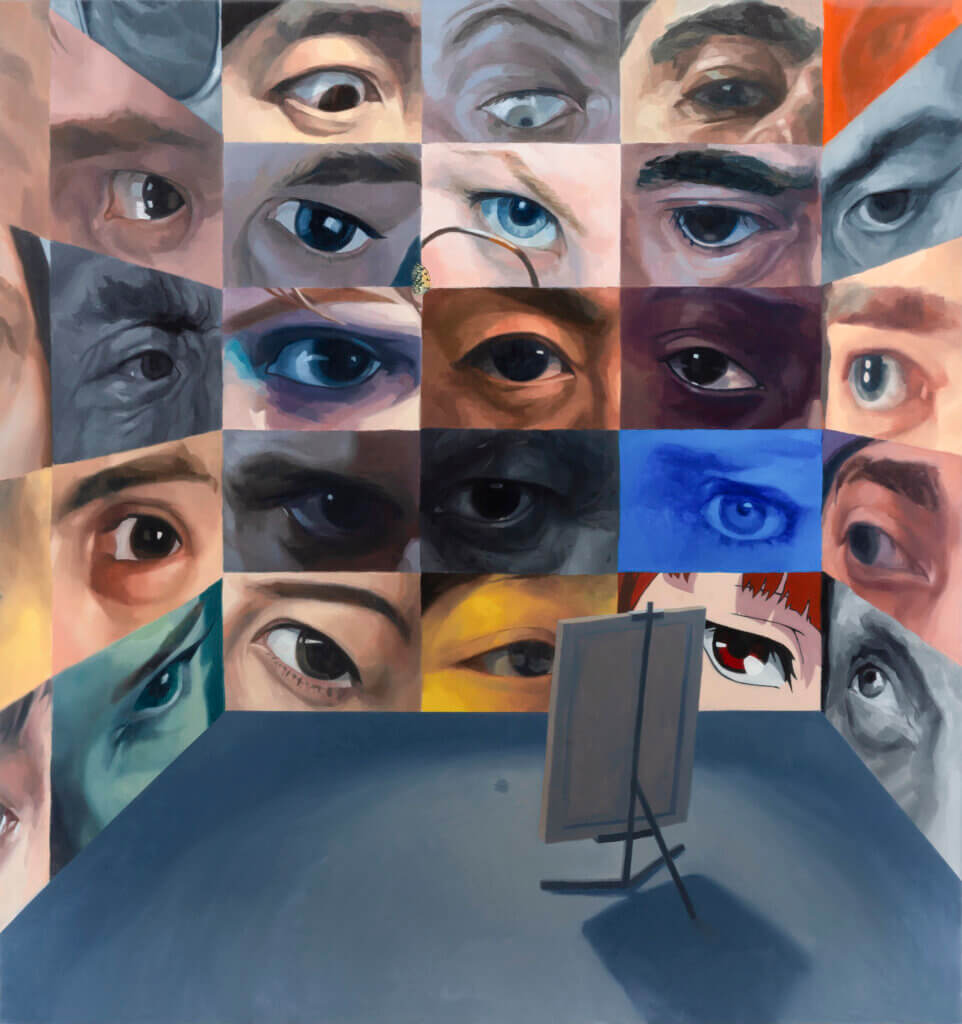
Yuri Yuan
Metamorphosis, 2022
oil on linen
72 x 68 in. (182.9 x 172.7 cm.)
This painting shows a canvas being looked at by many different eyes, almost like surveillance. The artist is gone or evolved into a butterfly, or the artist was a butterfly, I’ll leave it for the viewer to freely interpret the narrative in the work. The Greek word for “butterfly” is psyche, as in the soul of the dead. Butterflies are often used as a symbol of the soul exiting the body, freed from death.
Each eye is taken from a different movie, most of them are psychological thrillers: Dr. Strange Love (1964), The Truman Show (1998), Aguirre, Wrath of God (1972), After Yang (2021), In the Mood for Love (2000), Under the Skin (2013), The Lighthouse (2019), Taxi Driver (1976), Nightmare Alley (2021), No Man’s Land (2013), Se7en (1995), Last Night in Soho (2021), Green Room (2015), Gone Girl (2014), Vertigo (1958), Eyes Wide Shut (1999), Everything Everywhere All At Once (2022), Macbeth (2021), Black Coal Thin Ice (2014), Pan’s Labyrinth (2006), The Killing of a Sacred Deer (2017), Get Out (2017), Mulholland Drive (2001), Paprika (2006), Blade Runner 2049 (2017), Wings of Desire (1987), The Power of the Dog (2021), The Grand Budapest Hotel (2014), and The Seventh Seal (1957).
I want to emphasize that the movies were selected based on both their aesthetic value/cinematography as well as their concepts/narratives. For example, the anime eye is from Paprika, an animated psychological thriller film that discusses the ability to see other people’s dreams and as a result, losing one’s own identity (Christopher Nolan cites this film as an influence for his film Inception (2010). In my opinion, Paprika is a much better film).
Even though this painting looks the oddest in this group of paintings (perhaps formally), I would argue that the sense of weirdness and eeriness, “the strange with the familiar”, is shared among all of the works. (4)
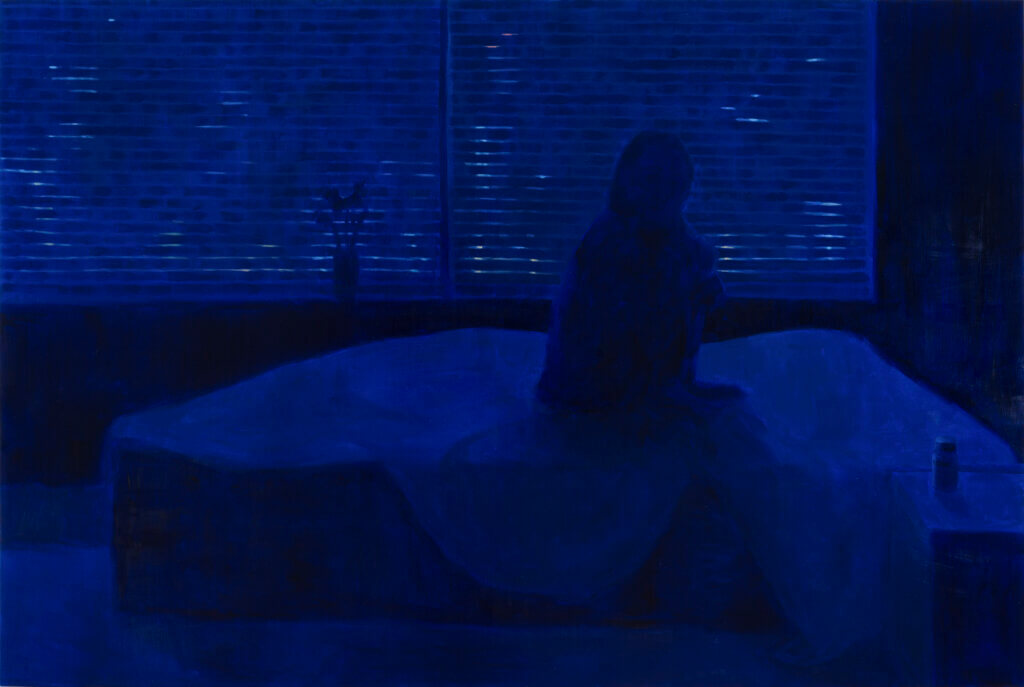
Yuri Yuan
Nightmare, 2022
oil on linen
48 x 72 in. (121.9 x 182.9 cm.)
Sometimes when I can’t sleep, I take Melatonin (a type of Vitamin to help people fall asleep). But the side effects of Melatonin cause me to have nightmares. My ability as an artist to visualize stories and remember images made the nightmares so much worse. Sometimes in my dream, I can recognize that it is a dream and I will try to remember the colors so that I can paint them later. Rather than being scared, I think most of the time I was just puzzled about how the stories and images came together in my dream, and what are the symbolic meanings of these dreams.
Henry Fuseli
The Nightmare, 1781
oil on canvas
40 1/16 × 50 1/16 in. (101.7 × 127.1 cm.)
Detroit Institute of Arts, Founders Society Purchase with funds from Mr. and Mrs. Bert L. Smokler and Mr. and Mrs. Lawrence A. Fleischman, 55.5.A.
Like many of the paintings in this body of work, Nightmare references a specific painting in art history, this time Henry Fuseli’s The Nightmare (1781). I always knew that I was going to make a painting referencing Fuseli’s painting, but I was trying to find a way that would make the scene even more enigmatic. In the painting, I replaced the monkey-like devil with a silhouette of my own body, waking in the middle of the night unable to distinguish between dreams and reality.
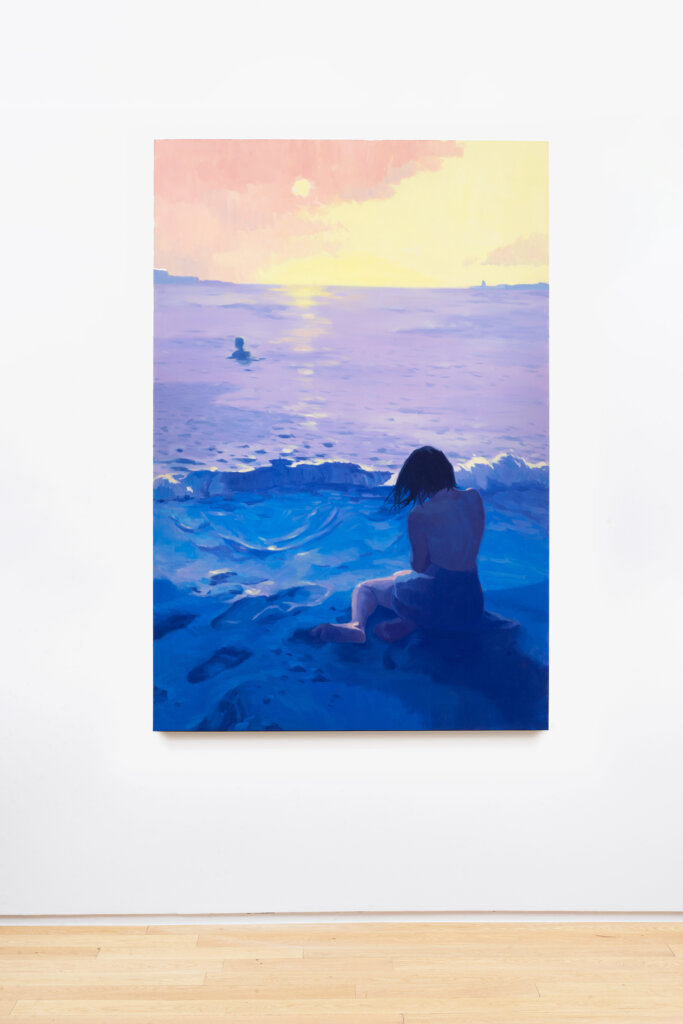
Yuri Yuan
Farewell, 2022
oil on linen
72 x 48 in. (182.9 x 121.9 cm.)
Like many of my paintings—Norwegian Wood (2020), for example—Farewell features the main figure turned away from the viewer. The footsteps next to her imply that someone, perhaps the tiny silhouette further away, walked into the ocean. The color palette of the painting is influenced by Gauguin’s paintings, especially the ones he did in Tahiti.
Yuri Yuan
Norwegian Wood, 2020
oil on canvas
62 x 72 1/2 in. (157.5 x 184.2 cm.)
Included in Yuri Yuan: River Flows in You (July 21-August 31, 2021) at Alexander Berggruen, NY.
Private collection.
Tales of NYC is an ongoing series of work where I paint from my observation and memories of living in New York City.
Small talk depicts a scene of a socializing/networking event. It is similar to A Train (2021) in the way that it is about loneliness as a social condition and the anxiety and exhaustion that comes with socializing.
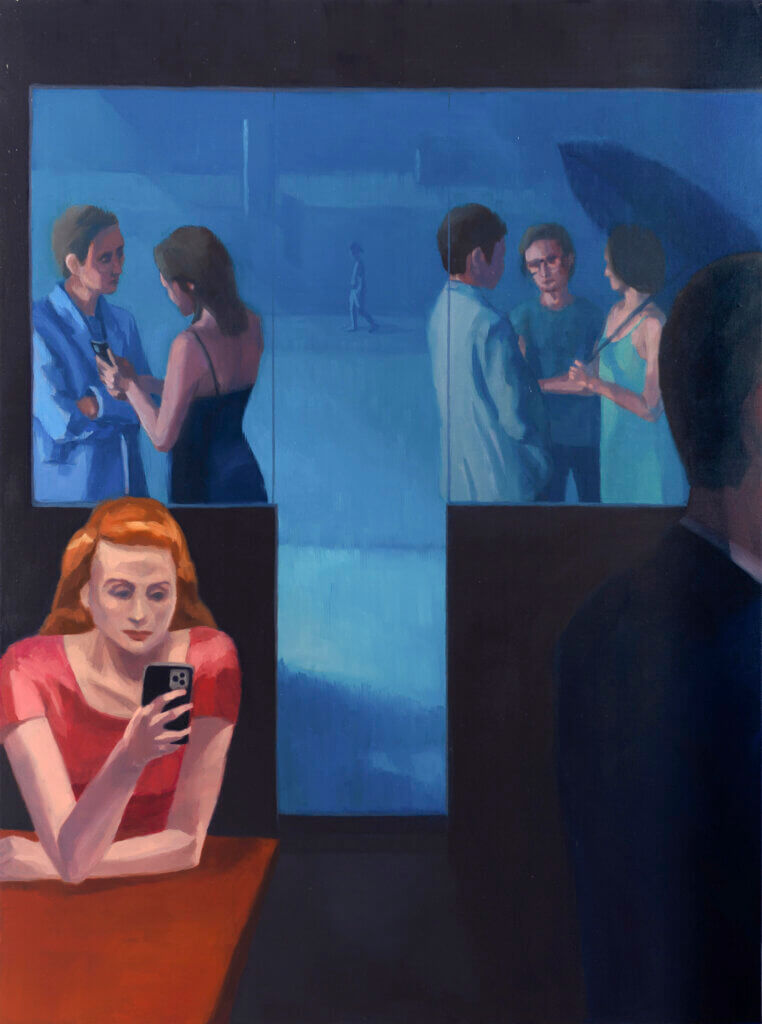
Yuri Yuan
Tales of NYC: Small Talk, 2022
oil on linen
48 x 36 in. (121.9 x 91.4 cm.)
The woman in the foreground is borrowed from Edward Hopper’s Nighthawks (1942) (I gave her an iPhone because it’s 2022). Two people behind her are exchanging contacts: “What kind of work do you make?” “Oh Let me show you my Instagram!” Three people next to them are probably discussing the latest gossip: who is dating whom, who flipped whose work, who made money from NFT.
They are framed by the window of the restaurant. The window is deliberately set for a 9:16 ratio, similar to the cinema screen. It gives the exterior scene a cinematic feeling, almost like it is a screen/imagination projected from the woman in red’s phone. Further away from the group, a person is walking alone on the street, separated from the crowd by the narrow door. This painting is inspired by my interaction with the art world, both the FOMO (fear of missing out) and the JOMO (joy of missing out). But I think its implication can be extended beyond the art world, to everyone living in fast-paced cities like New York, to everyone working in a capitalist society.
The window is deliberately set for a 9:16 ratio, similar to the cinema screen. It gives the exterior scene a cinematic feeling, almost like it is a screen/imagination projected from the woman in red’s phone. Further away from the group, a person is walking alone on the street, separated from the crowd by the narrow door. This painting is inspired by my interaction with the art world, both the FOMO (fear of missing out) and the JOMO (joy of missing out). But I think its implication can be extended beyond the art world, to everyone living in fast-paced cities like New York, to everyone working in a capitalist society.
(1) Mark Fisher, Capitalist Realism: Is There No Alternative?, p.19, Zero Books, 2010.
(2) James Henry Jr, “Take Me down Easy,” Genius, Accessed August 15, 2022.
(3) Rebecca Solnit, A Field Guide to Getting Lost, p.30, Vancouver, B.C.: Langara College, 2018.
(4) Fisher, The Weird and the Eerie, London, Repeater Books, 2016.
Edward Hopper
Nighthawks, 1942
oil on canvas
33 1/8 x 60 in. (84.1 x 152.4 cm.)
Collection of the Art Institute of Chicago, Friends of American Art Collection.
Yuri Yuan: Dark Dreams will run at Alexander Berggruen (1018 Madison Avenue, Floor 3) from September 7-October 12, 2022. The exhibition’s preview is available upon request. For all inquiries, please contact the gallery at info@alexanderberggruen.com.
Yuri Yuan: Dark Dreams (September 7-October 12, 2022) at Alexander Berggruen, New York.
Artwork and Installation Photos: Philipp Hoffmann